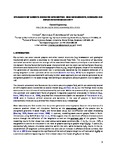Dynamics of rip currents associated with groynes — field measurements, modelling and implications for beach safety
| dc.contributor.author | Scott, T | |
| dc.contributor.author | Austin, M | |
| dc.contributor.author | Masselink, G | |
| dc.contributor.author | Russell, P | |
| dc.date.accessioned | 2017-02-16T16:06:27Z | |
| dc.date.available | 2017-02-16T16:06:27Z | |
| dc.date.issued | 2016-01 | |
| dc.identifier.issn | 0378-3839 | |
| dc.identifier.issn | 1872-7379 | |
| dc.identifier.uri | http://hdl.handle.net/10026.1/8520 | |
| dc.description.abstract |
Rip currents can occur around groynes and other coastal structures (e.g. breakwaters and geological headlands), which provide a boundary to the wave-induced flow field and present a hazard to water users worldwide. Shore-normal groynes are common along drift-aligned coasts. In northern Europe these are often low-energy, fetch-limited environments that are dominated by locally generated wind waves. The presence of boundary-controlled rip currents due to groynes is supported anecdotally in literature, but few field measurements of their presence and dynamics exist. This study provides new quantitative scientific understanding of the dynamics of boundary-controlled rip currents within this setting. A 10-day field experiment at Boscombe beach on the south coast of England measured rip currents and nearshore hydrodynamics around an impermeable groyne field. Observations from both fixed instruments (wave, tide and current metres) and GPS-drifters confirmed the presence and characteristics of hazardous topographic rip currents around a groyne structure during a number of oblique wave events and drift reversals. The strongest offshore-directed rip velocities of up to 1ms-1 (10-min average) and 2ms-1 (instantaneous) were measured on the updrift side of the groyne where the longshore current generated within the embayment was deflected offshore. These strong rip flows were measured under relatively small wave heights (Hs<1m) and presented a significant bathing hazard. A calibrated and validated numerical model (XBeach) was used, in support of measured data, to explore the key environmental controls on rip behaviour across a range of groyne configurations and wave conditions not observed in the field. Key outcomes were that: 1) upstream deflected rip flows were found to be strongly correlated to the alongshore thrust due to wave forcing; 2) the groyne length relative to surf zone width strongly controlled the offshore extent of rip flows, with a significant increase in surf zone exits above a relative groyne length (length/surf width) of 1.25; and 3) rip flows increase up to a relative groyne spacing (spacing/length) of around 4-6, above which alongshore currents are fully developed. These findings have been distilled into some key principals that are relevant to the assessment of boundary-controlled rip hazard on beaches. | |
| dc.format.extent | 53-69 | |
| dc.language | en | |
| dc.language.iso | en | |
| dc.publisher | Elsevier BV | |
| dc.subject | Rip current | |
| dc.subject | Beach | |
| dc.subject | Groyne | |
| dc.subject | Coastal hazard | |
| dc.subject | XBeach | |
| dc.title | Dynamics of rip currents associated with groynes — field measurements, modelling and implications for beach safety | |
| dc.type | journal-article | |
| dc.type | Article | |
| plymouth.author-url | https://www.webofscience.com/api/gateway?GWVersion=2&SrcApp=PARTNER_APP&SrcAuth=LinksAMR&KeyUT=WOS:000366791700005&DestLinkType=FullRecord&DestApp=ALL_WOS&UsrCustomerID=11bb513d99f797142bcfeffcc58ea008 | |
| plymouth.volume | 107 | |
| plymouth.publication-status | Published | |
| plymouth.journal | Coastal Engineering | |
| dc.identifier.doi | 10.1016/j.coastaleng.2015.09.013 | |
| plymouth.organisational-group | /Plymouth | |
| plymouth.organisational-group | /Plymouth/Admin Group - REF | |
| plymouth.organisational-group | /Plymouth/Admin Group - REF/REF Admin Group - FoSE | |
| plymouth.organisational-group | /Plymouth/Faculty of Science and Engineering | |
| plymouth.organisational-group | /Plymouth/Faculty of Science and Engineering/School of Biological and Marine Sciences | |
| plymouth.organisational-group | /Plymouth/REF 2021 Researchers by UoA | |
| plymouth.organisational-group | /Plymouth/REF 2021 Researchers by UoA/UoA07 Earth Systems and Environmental Sciences | |
| plymouth.organisational-group | /Plymouth/Research Groups | |
| plymouth.organisational-group | /Plymouth/Research Groups/Marine Institute | |
| plymouth.organisational-group | /Plymouth/Users by role | |
| plymouth.organisational-group | /Plymouth/Users by role/Academics | |
| plymouth.organisational-group | /Plymouth/Users by role/Researchers in ResearchFish submission | |
| dc.rights.embargodate | 2017-01-01 | |
| dc.identifier.eissn | 1872-7379 | |
| dc.rights.embargoperiod | 12 months | |
| rioxxterms.funder | Natural Environment Research Council | |
| rioxxterms.identifier.project | Dynamics of Rip currents and Implications for Beach Safety (DRIBS) | |
| rioxxterms.versionofrecord | 10.1016/j.coastaleng.2015.09.013 | |
| rioxxterms.licenseref.uri | http://www.rioxx.net/licenses/under-embargo-all-rights-reserved | |
| rioxxterms.type | Journal Article/Review | |
| plymouth.funder | Dynamics of Rip currents and Implications for Beach Safety (DRIBS)::Natural Environment Research Council |


